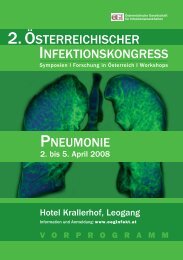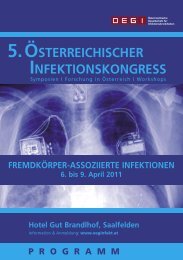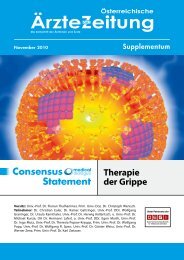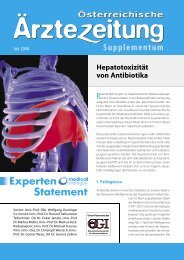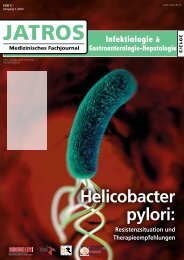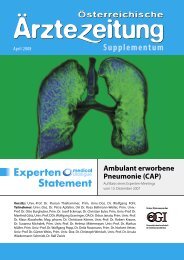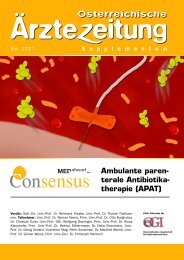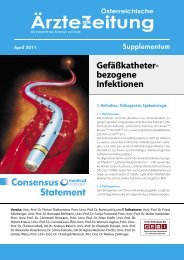Influenza: Aktuelles und State of the Art - Österreichische ...
Influenza: Aktuelles und State of the Art - Österreichische ...
Influenza: Aktuelles und State of the Art - Österreichische ...
Erfolgreiche ePaper selbst erstellen
Machen Sie aus Ihren PDF Publikationen ein blätterbares Flipbook mit unserer einzigartigen Google optimierten e-Paper Software.
JATROS Infektiologie 4 I 2011<br />
Treating bacterial meningitis<br />
The role <strong>of</strong> adjunctive steroids<br />
Steroids have an important place in <strong>the</strong> treatment <strong>of</strong> bacterial meningitis (BM), according to scheduled<br />
ICAAC presenter W. Michael Scheld, MD, University <strong>of</strong> Virginia, Charlottesville, Virginia, USA. Although<br />
Dr. Scheld was unable to attend this year’s ICAAC, he graciously agreed to share highlights from that talk<br />
for <strong>the</strong> benefit <strong>of</strong> MD Conference Express readers.<br />
The rationale for employing anti-inflammatory<br />
medication in <strong>the</strong> treatment <strong>of</strong> BM<br />
is based upon <strong>the</strong> observation that hyperactive<br />
central nervous system (CNS) immune<br />
responses <strong>und</strong>erlie brain swelling<br />
and neuronal loss and likely contribute<br />
to morbidity and mortality. In animals,<br />
steroids have been shown to reduce CNS<br />
inflammation, intracranial pressure, and<br />
neuronal loss. In addition, new investigational<br />
anti-inflammatory agents, such as recombinant<br />
tumor necrosis factor-related<br />
apoptosis-inducing ligand (rTRAIL), significantly<br />
decrease cerebrospinal fluid leukocytes<br />
and apoptosis in mouse models <strong>of</strong><br />
pneumococcal meningitis and sig nificantly<br />
improve survival (Fig.) [H<strong>of</strong>fmann O et al,<br />
J Clin Invest 2007].<br />
After review <strong>of</strong> <strong>the</strong> clinical literature over<br />
<strong>the</strong> past decade, Dr. Scheld concluded that<br />
intravenous dexamethasone for <strong>the</strong> first 2<br />
to 4 days in <strong>the</strong> treatment <strong>of</strong> communityacquired<br />
BM is recommended in all ages<br />
in developed nations. De Gans J et al demonstrated<br />
an overall reduced risk for unfavorable<br />
outcomes and mortality in adults<br />
(RR=0.59, 95% CI 0.37 to 0.94 p=0.03<br />
and RR 0.48, 95% CI 0.24 to 0.96;<br />
p=0.04, respectively) with dexamethasone<br />
use [New Engl J Med 2002]. Data out <strong>of</strong><br />
<strong>the</strong> Ne<strong>the</strong>rlands reveal that national implementation<br />
<strong>of</strong> adjunctive dexamethasone in<br />
S. pneumoniae BM treatment has significantly<br />
reduced un favorable outcomes, hearing<br />
loss, and mortality [Brouwer MC et<br />
al, Neurology 2010].<br />
In contrast, steroids are not recommended<br />
where resources are limited and in populations<br />
with high HIV-positivity rates. A<br />
Vietnamese study showed a benefit to dexamethasone<br />
use only among patients with<br />
a proven microbiological diagnosis <strong>of</strong> BM<br />
but not among those with a probable diagnosis<br />
[Nguyen TH et al, New Engl J Med<br />
2007]. A study out <strong>of</strong> Malawi among<br />
patients with high rates <strong>of</strong> HIV infection<br />
showed no benefit to using steroids in <strong>the</strong><br />
treatment <strong>of</strong> BM [Scarborough M et al,<br />
New Engl J Med 2007]. Fur<strong>the</strong>r, a 2010<br />
metaanalysis that examined <strong>the</strong> issue<br />
showed that benefits <strong>of</strong> reduced hearing<br />
loss and neurologic sequelae but not over -<br />
all mortality among patients with BM<br />
who were treated with adjunctive steroids<br />
were observed in developed nations only<br />
[Brouwer MC et al, Cochrane Rev 2010].<br />
O<strong>the</strong>r potential tactics for improving BM<br />
outcomes include selection <strong>of</strong> highly<br />
bactericidal, nonlytic antibacterials, such<br />
as rifam pin, which has been shown to<br />
reduce beta-lactam-induced cytotoxicity in<br />
animals [Spreer A et al, Crit Care Med<br />
2009], and daptomycin plus ceftriaxone,<br />
which has been associated with reduced<br />
neuronal injury and hearing loss [Grandgirad<br />
et al, ECCMID 2009]. In addition,<br />
prompt initiation <strong>of</strong> antibacterial <strong>the</strong>rapy<br />
has been shown to reduce mortality<br />
[Proulx N et al, Q J Med 2005; Auburtin<br />
M et al, Crit Care Med 2006] and remains<br />
a central tenant <strong>of</strong> proper treatment.<br />
Report: Noelle Lake, MD<br />
A B C D<br />
200<br />
** 100<br />
**<br />
CSF bacteria<br />
(CFU/ml)<br />
10 9<br />
10 8<br />
10 7<br />
10 6<br />
rTRAIL (µg) 0 1<br />
CSF leukocytes<br />
(1/µl)<br />
12.000<br />
10.000<br />
80<br />
150<br />
8.000<br />
60<br />
**<br />
––––– Untreated<br />
100<br />
6.000<br />
40<br />
––––– rTRAIL 1µg<br />
4.000<br />
20<br />
50<br />
2.000<br />
0<br />
0<br />
0<br />
rTRAIL (µg) 0 1 0 4 8 12 16 20 24h rTRAIL (µg) 0 1<br />
Survival (%)<br />
Fig.: Effects <strong>of</strong> treatment with rTRAIL in meningitis induced by live pneumococci in mice. (A) At 24 hours after infection, CSF bacterial load in untreated<br />
and rTRAIL-treated wild-type mice did not differ. (B) CSF leukocyte concentration was significantly lower in rTRAIL-treated mice than in controls. **p





